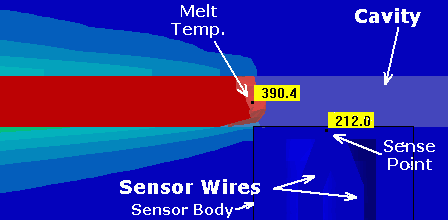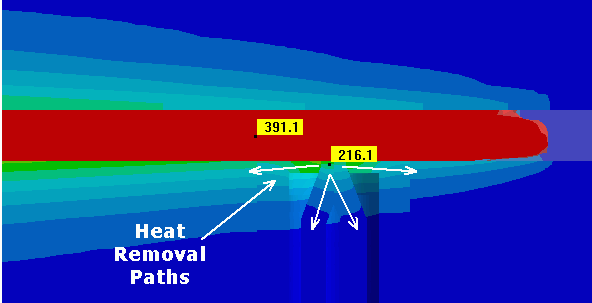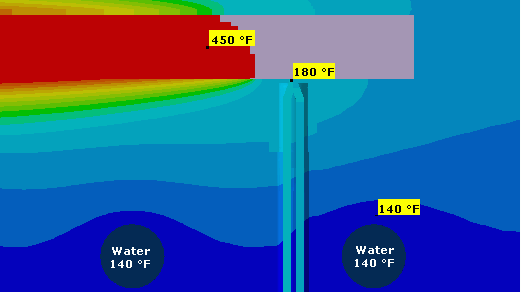Tip of the Day 151: What Does A Cavity Temperature “See”?
A few customers have become confused thinking that temperature sensors placed into the wall of a cavity can measure melt temperature. But this is not true because…
-
- The mold in which the sensor is mounted is a tremendous heat sink.
-
- The plastic is a good insulator that prevents the heat from the melt getting out to the sensor quickly enough to raise its temperature.
When the flow front arrives at the sensor the mold and sensor are at the same temperature: cold relative to the melt.

When the melt flows by the heat from it begins to flow into the sensor. But at the same time the steel around the sensor and the wires themselves are removing heat from the junction point where the temperature is measured.

This heat removal path is of large mass and free flowing. Before the melt can heat the sensor to melt temperature the heat is removed. Thus, as the part cools heat is removed from the cavity wall faster than it can be removed from the part.
Thus the cavity temperature sensor never reaches the melt temperature.
An animation of the process is available below.
https://www.youtube.com/watch?v=W1gd26msFjo
The Sensor Sees “Mold Temperature”
The plastic variable “Mold Temperature” is important to know in many cases: dimensionally critical semi-crystalline parts, thin-wall parts (for flow) and thick-wall parts for proper cooling. But the coolant temperature is NOT the same as the mold surface temperature.
After the process has stabilized there is a flow of heat out of the mold on every cycle. This flow creates a temperature gradient from the cavity surface to the coolant.

The “true” mold temperature, 180 °F, as the plastic sees it, is the temperature at the surface of the cavity. This value the sensor can see quite well. It is the value from the previous cycle less what the water was able to pull out before the next shot.
As the mold cools before the arrival of the next flow front the last sensor temperature before the flow front arrives is the mold temperature at that point. In other words, this is the only mold temperature that the plastic ever “knows”. The eDART™ records this as the summary value type “Minimum”
Seeing Changes in Melt Temperature – Indirectly
The eDART calculates a value called “Effective Melt Temperature” that can allow the cavity temperature sensor to detect changes in the melt temperature at the sensor. This method detects change only, not absolute melt temperature.
You can read more at tip # 152.